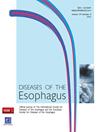372. 纵隔镜食管切除术术后肺炎的危险因素分析
IF 2.3
3区 医学
Q3 GASTROENTEROLOGY & HEPATOLOGY
引用次数: 0
摘要
肺炎是食管切除术中常见的并发症。尽管纵隔镜食管切除术中肺炎的发生率较低,但肺炎的危险因素尚不清楚。对风险因素进行了调查。本研究回顾性分析了我院2016年至2021年收治的食管癌症纵隔镜下食管消泡术和胃导管重建术患者244例。术后肺炎被诊断为Clavien-Dindo 2级或更高级别。患者分为两组 = 21)和不带(n = 223)肺炎,以及背景、手术因素或组织病理学因素。术后肺炎21例(8.6%),术前白蛋白、PNI(<45)、PLR(>122)和手术出血(>134)与术后肺炎有显著相关性(p < 年龄和既往呼吸道疾病也与术后肺炎有关,但不显著。在多变量分析中,低PNI是术后肺炎的独立危险因素(p = 0.047,或 = 2.74)。术后肺炎与吻合口瘘或复发性神经麻痹等并发症无关。即使在术前呼吸功能障碍的患者中,也没有观察到与术后肺炎的相关性。据报道,PNI可作为术后并发症的预测指标。在本研究中,它也是术后肺炎的一个预测因素。癌症食管营养不良患者的早期营养干预可预防术后肺炎。低PNI可能是纵隔镜食管切除术后肺炎的一个预测因素。本文章由计算机程序翻译,如有差异,请以英文原文为准。
372. INVESTIGATION OF RISK FACTORS OF POSTOPERATIVE PNEUMONIA IN MEDIASTINOSCOPIC ESOPHAGECTOMY
Pneumonia is a usual complication in esophagectomy. Although frequency of pneumonia in mediastinoscopic esophagectomy is low, risk factors for pneumonia are unclear. The risk factors are investigated.
Two hundred and forty-four patients with mediastinoscopic esphagectomy and gastric tube reconstruction for esophageal cancer from 2016 to 2021 in our hospital were retrospectively considered in the present study. Postoperative pneumonia was diagnosed as Clavien-Dindo grade 2 or higher. Patients were divided into two groups with (n = 21) and without (n = 223) pneumonia, and background, surgical factors, or histopathological factors were investigated.
Post-operative pneumonia was observed in 21 patients (8.6%), and pre-operative albumin, PNI (< 45), PLR (> 122), and operative bleeding (>134) were significantly related with post-operative pneumonia in the univariate analysis (p < 0.05). Age and previous respiratory disease were also tended to be related with post-operative pneumonia, but not significant. Low PNI was an independent risk factor of post-operative pneumonia in the multivariate analysis (p = 0.047, OR = 2.74). Post-operative pneumonia was not related to the complications, such as anastomosis leakage or recurrent nerve paralysis. No correlation with postoperative pneumonia was observed even in patients with preoperative respiratory dysfunction.
PNI has been reported to be useful as a predictor of postoperative complications. In the present study, it was also a predictor factor of postoperative pneumonia. Early nutritional intervention for undernourished esophageal cancer patients may prevent postoperative pneumonia.
Low PNI can be a predictive factor of postoperative pneumonia in the mediastinoscopic esophagectomy.
求助全文
通过发布文献求助,成功后即可免费获取论文全文。
去求助
来源期刊

Diseases of the Esophagus
医学-胃肠肝病学
CiteScore
5.30
自引率
7.70%
发文量
568
审稿时长
6 months
期刊介绍:
Diseases of the Esophagus covers all aspects of the esophagus - etiology, investigation and diagnosis, and both medical and surgical treatment.
 求助内容:
求助内容: 应助结果提醒方式:
应助结果提醒方式:


